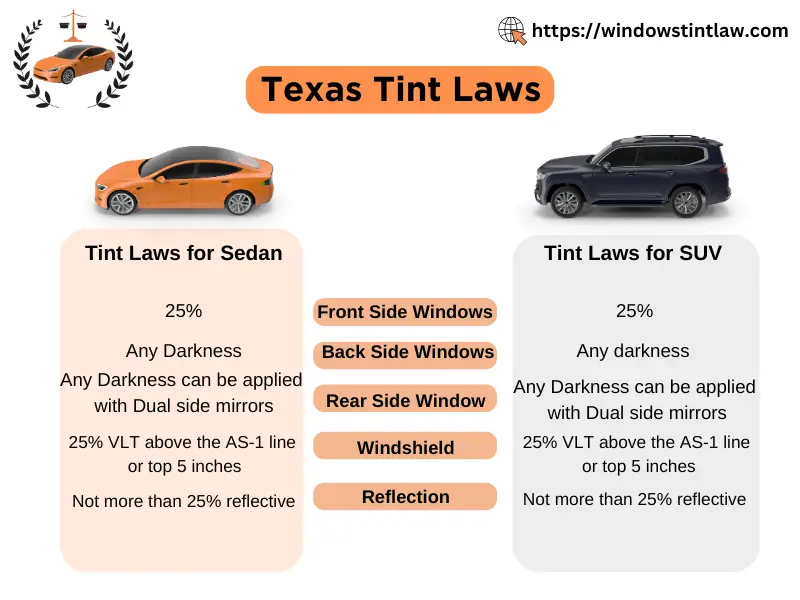Texas Tint laws were legislated in 1995 to steer how tinted materials can be applied to vehicles.
Texas tint laws are not applicable for Law Enforcement vehicles, Buses, Taxis and all vehicles operated by person having medical exemption certificate. However, all other vehicle must obey the window tinting regulations of Texas to avoid Penalties or Tint tickets.
Motorists can enjoy the benefits of Tinted windows but on the other side Be careful to install illegal tints which impairs the drivers vision to a large extent. As the lower visibility from vehicle windows can lead to personal injury in crash or accident.
Window Tinting Laws of all US states primarily focus on Visible Light Transmission and Solar reflectance where Visible Light transmission is the amount of light that passes through vehicle windows with tinting or glazing material installed. Solar reflectance refers to the amount of light which reflects from windows glass with a coating material applied.
Follow the below sections to get detailed insights of Texas Tint laws.
Overview of Texas Tint Laws
The below infographic shows the permissible limits of tint darkness and tint reflection for Cars and SUVs operated in Texas. Front windshield tint is not allowed, however a clear or transparent UV film like Crystalline tint can be applied.

Vehicle Windows on the left and right side of the driver having less than 25% VLT cannot pass the inspection, regardless of the vehicle model year.
Darkest Legal Tint in Texas
The below table shows the darkest allowed tint percentages for Cars and SUVs operated in Texas:
| State | Front Side Windows | Back Side Windows | Rear Window | Front Windshield | Tint Reflection | Color Restrictions |
| Texas | 25% | Any Tint Darkness | Any darker tint can be applied with dual side mirrors | 25% VLT above the AS-1 line or top 5 inches. | Not more than 25% reflective. | Red, Amber and Blue Tint colors are not permitted. |
Window Tint Reflection
Sun screening or tinting materials applied on vehicles must not reflect more than 25% light. The same rule is applicable to Cars and SUVs, Vans or Trucks.
Window coating materials with higher solar reflectance may cause discomfort for other drivers as it produces glare due to sunlight and headlamps of other vehicles.
Other Rules and Regulations
Besides Tint Darkness and reflections limits, there are some other rules to be followed by drivers:
- Dual Side Mirrors: Dual side mirrors are mandatory if the rear window is tinted. Otherwise rear window must have 25% VLT.
- Tint Colors Restriction: Red, Amber and Blue tint colors are prohibited.
- Certificates: Window film manufacturer are required to certify the tinting materials they sell in Texas.
- Stickers: To identify legal tint, a sticker or label of at least one inch in size must be affixed between the window and the tint material.
Medical Exemption
The Texas Department of Public Safety has discontinued providing medical exemption permits effective January 1, 2019. The Department will not accept or consider applications for the Medical Exemption certificate.
Penalties for Violating Tint Laws
Police can stop any motorist, if they suspect illegal tint is applied on car windows. Cops can test the window tint darkness and if found illegal, driver may get a “fix it ticket” of $20. Fix it tickets means to remove the illegal tinting material or replace with materials which meets the requirements of state tint rules.
Subsequent tickets can reach up to $275 including the court fee and might continue to increase with further violations. Hence, drivers are advised to install the legal tinting or coating materials to avoid getting pulled over by the enforcement agencies.
According to Texas Transportation Code Sec. 547.613. RESTRICTIONS ON WINDOWS , Any individual or business that installs or attaches film material that changes the color or decreases light transmission in violation of state laws commits a misdemeanor punishable by a fine of up to $1,000.
